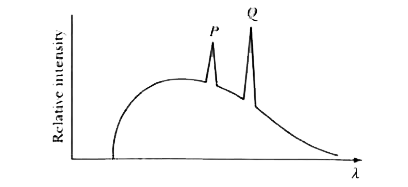PRACTICE QUESTIONS (SINGLE CORRECT CHOICE TYPE) from RESNICK AND HALLIDAY PHYSICS (HINGLISH) ALL ABOUT ATOMS for Class 12
| Class 12 | PHYSICS |
| Chapter | ALL ABOUT ATOMS |
| RESNICK AND HALLIDAY PHYSICS (HINGLISH) | PRACTICE QUESTIONS (SINGLE CORRECT CHOICE TYPE) |
| Medium | English |
| Academic Year | 2023-2024 |
Question 31
The following figure shows the intensity-wavelength relations of x-rays coming from two different Coolidge tubes. The solid curve represents the relation for tube A in which the potential difference between the target and the filament is VA and the atomic number of the target material is ZA. These quantities are VBandZB for the other tube. Then
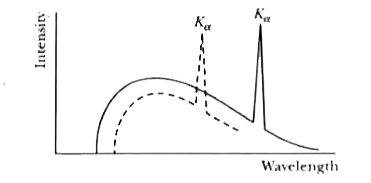 View Solution
View SolutionQuestion 58
A single electron orbits around a stationary nucleus of charge +Ze where Z is a constant and e is the magnitude of electronic charge. It requires 47.2 eV to excite the electron from the second bohr orbit to the third bohr orbit
a. Find the value of Z
b. Find the energy required to excite the electron from n=3 to n=4
c. Find the wavelength of radiation required to remove the electron from the second bohr orbit to infinity
d. Find the kinetic energy, potential energy and angular momentum of the electron in the first orbit
e. Find the ionisation energy of above electron system in electron-volt.View SolutionQuestion 62
When a particle is restricted to move along x-axis between x=0 and x=a, where α if of nenometer dimension, its energy can take only certain specific values. The allowed energies of the particle moving in such a restricted region, correspond to the formation of standing waves with nodes at its ends x=0 and x=a. The wavelength of this standing wave is related to the linear momentum p of the particle according to the de Broglie relation. The energy of the particle of mass m is related to its linear momentum as E=p22m. Thus the energy of the particle can be denoted by a quantum number n taking values 1,2,3, ...(n=1, called the ground state) corresponding to the number of loops in the standing wave.
Use the model described above to answer the following three questions for a particle moving along the line from x=0 to x=α. Take h=6.6×10−34Js and e=1.6×10−19 C.
Q. The allowed energy for the particle for a particular value of n is proportional to View SolutionQuestion 63
When a particle is restricted to move along x-axis between x=0 and x=a, where α if of nenometer dimension, its energy can take only certain specific values. The allowed energies of the particle moving in such a restricted region, correspond to the formation of standing waves with nodes at its ends x=0 and x=a. The wavelength of this standing wave is related to the linear momentum p of the particle according to the de Broglie relation. The energy of the particle of mass m is related to its linear momentum as E=p22m. Thus the energy of the particle can be denoted by a quantum number n taking values 1,2,3, ...(n=1, called the ground state) corresponding to the number of loops in the standing wave.
Use the model described above to answer the following three questions for a particle moving along the line from x=0 to x=α. Take h=6.6×10−34Js and e=1.6×10−19 C.
Q. If the mass of the particle is m=1.0×10−30kg and α=6.6nm, the energy of the particle in its ground state is closest to View SolutionQuestion 64
When a particle is restricted to move along x-axis between x=0 and x=a, where α if of nenometer dimension, its energy can take only certain specific values. The allowed energies of the particle moving in such a restricted region, correspond to the formation of standing waves with nodes at its ends x=0 and x=a. The wavelength of this standing wave is related to the linear momentum p of the particle according to the de Broglie relation. The energy of the particle of mass m is related to its linear momentum as E=p22m. Thus the energy of the particle can be denoted by a quantum number n taking values 1,2,3, ...(n=1, called the ground state) corresponding to the number of loops in the standing wave.
Use the model described above to answer the following three questions for a particle moving along the line from x=0 to x=α. Take h=6.6×10−34Js and e=1.6×10−19C
Q. The speed of the particle that can take discrete values is proportional to View SolutionQuestion 74
Match the statements in Column I labeled as (a), (b), (c ), and (d) with those in Column II labeled as (p), (q), (r ), and (s). Any given statement in Column I can have correct matching with one or more statements in Column II.
An electron in hydrogen atom moves from n=1 to n=2.
Column IColumn II(a) Angular momentum(p) One-forth times(b) Kinetic energy(q) Two times(c) Potential energy(r) Four times(d) Mechanical energy(s) Half timesView SolutionQuestion 75
Match the statements in Column I labeled as (a), (b), (c ), and (d) with those in Column II labeled as (p), (q), (r ), and (s). Any given statement in Column I can have correct matching with one or more statements in Column II.
Column IColumn II(a) Lithium atom(p) 54.4 eV(b) Helium atom(q) 13.6 eV(c) Beryllium atom(r) 122 eV(d) Hydrogen atom(s) 217.6 eVView SolutionQuestion 76
In each equation, there is a table having 3 columns and 4 rows. Based on the table, there are 3 questions. Each question has 4 options (a), (b), (c ) and (d), ONLY ONE of these four options is correct.
The x-rays have different penetration power. In the given table, Column I shows their penetration power of x-rays, Column II shows their frequenc and speed and Column III shows their wavelength range and mode of generation.
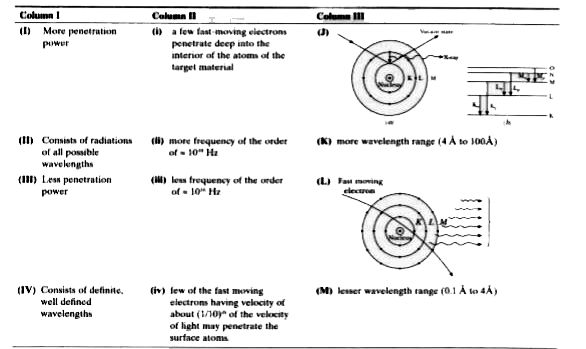
What are the characteristics of hard x-rays? View SolutionQuestion 77
In each equation, there is a table having 3 columns and 4 rows. Based on the table, there are 3 questions. Each question has 4 options (a), (b), (c ) and (d), ONLY ONE of these four options is correct.
The x-rays have different penetration power. In the given table, Column I shows their penetration power of x-rays, Column II shows their frequenc and speed and Column III shows their wavelength range and mode of generation.
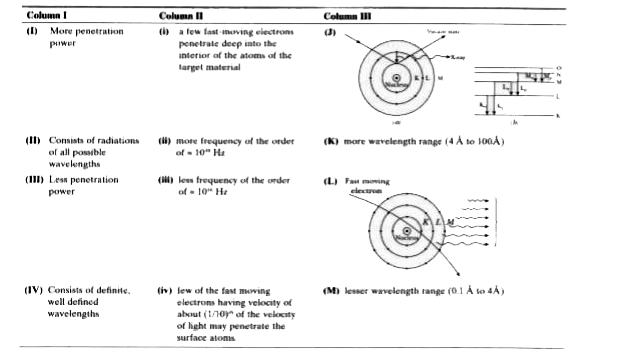
What are the characteristics of continuous x-rays? View SolutionQuestion 78
In each equation, there is a table having 3 columns and 4 rows. Based on the table, there are 3 questions. Each question has 4 options (a), (b), (c ) and (d), ONLY ONE of these four options is correct.
The x-rays have different penetration power. In the given table, Column I shows their penetration power of x-rays, Column II shows their frequenc and speed and Column III shows their wavelength range and mode of generation.
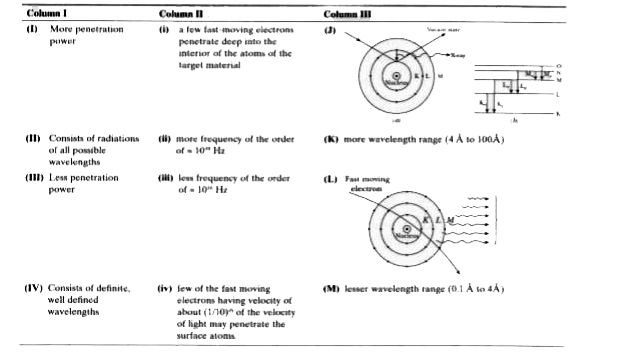
What are the characteristics of soft x-rays? View SolutionQuestion 79
In each equation, there is a table having 3 columns and 4 rows. Based on the table, there are 3 questions. Each question has 4 options (a), (b), (c ) and (d), ONLY ONE of these four options is correct.
There are different types of lasers. In the given table, Colums I shows the properties of different lasers or material used in lasers, Column II shows the different names of the lasers and Column III shows the uses of different type of lasers.
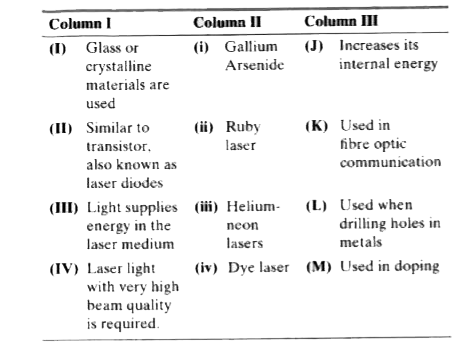
What are the characteristics of solid-state laser? View SolutionQuestion 80
In each equation, there is a table having 3 columns and 4 rows. Based on the table, there are 3 questions. Each question has 4 options (a), (b), (c ) and (d), ONLY ONE of these four options is correct.
There are different types of lasers. In the given table, Colums I shows the properties of different lasers or material used in lasers, Column II shows the different names of the lasers and Column III shows the uses of different type of lasers.
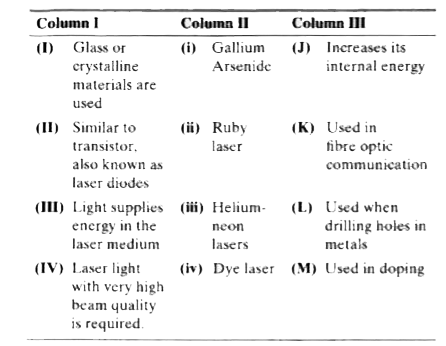
What are the characteristics of semiconductor laser? View SolutionQuestion 81
In each equation, there is a table having 3 columns and 4 rows. Based on the table, there are 3 questions. Each question has 4 options (a), (b), (c ) and (d), ONLY ONE of these four options is correct.
There are different types of lasers. In the given table, Colums I shows the properties of different lasers or material used in lasers, Column II shows the different names of the lasers and Column III shows the uses of different type of lasers.
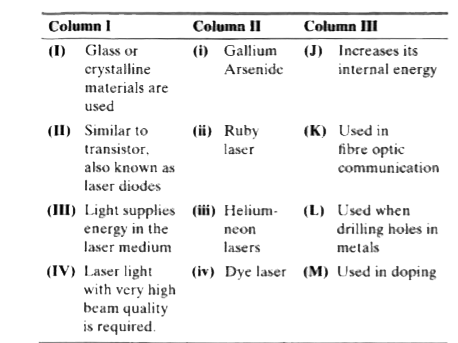
What are the characteristics of liquid state laser? View SolutionQuestion 82
In each equation, there is a table having 3 columns and 4 rows. Based on the table, there are 3 questions. Each question has 4 options (a), (b), (c ) and (d), ONLY ONE of these four options is correct.
Four quantum numbers shows the electronic configuration of the element. In the given table, Column I shows the different values of principal quantum number, Column II shows the different values of angular momentum quantum number and Column III shows the energy levels for different orbitals.
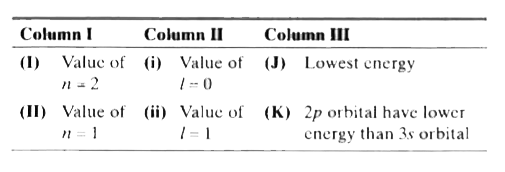
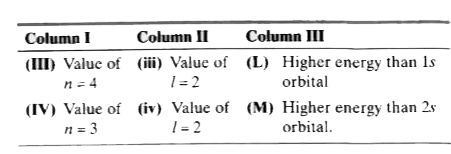
What are the characteristics of 1s orbital? View SolutionQuestion 83
In each equation, there is a table having 3 columns and 4 rows. Based on the table, there are 3 questions. Each question has 4 options (a), (b), (c ) and (d), ONLY ONE of these four options is correct.
Four quantum numbers shows the electronic configuration of the element. In the given table, Column I shows the different values of principal quantum number, Column II shows the different values of angular momentum quantum number and Column III shows the energy levels for different orbitals.


What are the characteristics of 2p orbital? View SolutionQuestion 84
In each equation, there is a table having 3 columns and 4 rows. Based on the table, there are 3 questions. Each question has 4 options (a), (b), (c ) and (d), ONLY ONE of these four options is correct.
Four quantum numbers shows the electronic configuration of the element. In the given table, Column I shows the different values of principal quantum number, Column II shows the different values of angular momentum quantum number and Column III shows the energy levels for different orbitals.


What are the characteristics of 2s orbital? View Solution

